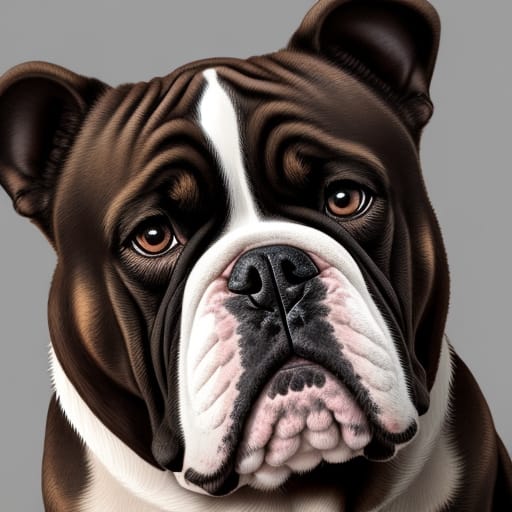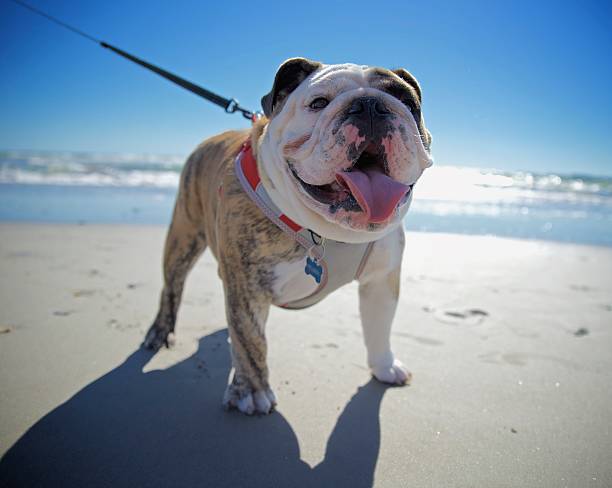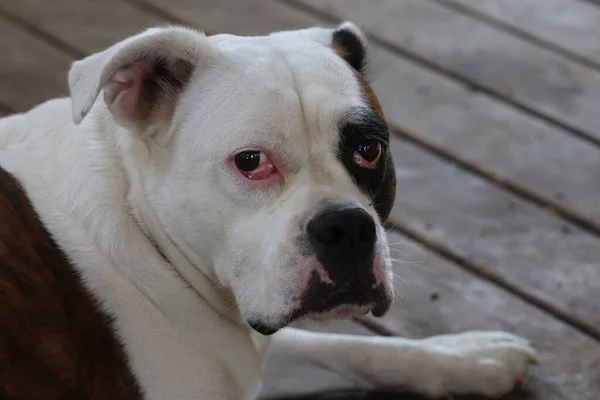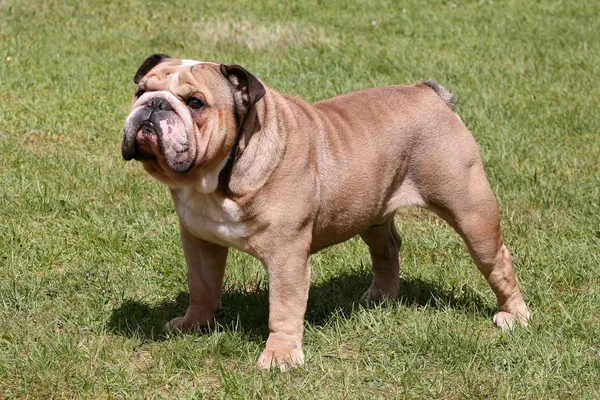The Victorian Bulldog, a majestic blend of power and gentleness, captivates the hearts of dog enthusiasts and families seeking a noble companion. With its distinctive appearance, gentle disposition, and undying loyalty, this breed has earned a well-deserved reputation as both a beloved family member and a tribute to Victorian-era elegance.

| Category (Explanation) | Breed Information |
|---|---|
| Year of Breed Conception | 1980s (Developed in the United Kingdom) |
| Country of Origin | United Kingdom |
| Weight (Male) | 70-75 lbs (32-34 kg) |
| Weight (Female) | 55-65 lbs (25-29.5 kg) |
| Coat Type | Short, dense, and smooth |
| Color Variations | Various, including brindle, fawn, and white |
| Shedding Level (Low, Moderate, High) | Low |
| Height (cm & in) | 16-19 inches (41-48 cm) |
| Breed Size | Medium to Large |
| Trainability (Low, Moderate, High) | Moderate |
| Mental Needs (Low, Moderate, High) | Moderate |
| Intelligence Level (Low, Moderate, High) | Moderate |
| Energy Level (Low, Moderate, High) | Moderate |
| Agility (Low, Moderate, High) | Moderate |
| Loyalty (Low, Moderate, High) | High |
| Playfulness (Low, Moderate, High) | Moderate |
| Exercise Needs | Regular exercise and playtime |
| Guarding Proficiency (Low, Moderate, High) | Moderate |
| Sociability with Children (Low, Moderate, High) | High |
| Barking Level (Low, Moderate, High) | Moderate |
| Digging Tendency (Low, Moderate, High) | Low |
| Destructive Behavior (Low, Moderate, High) | Low |
| Drooling Level (Low, Moderate, High) | Moderate to high |
| Obedience Level (Low, Moderate, High) | Moderate to high |
| Apartment Friendly (Yes/No) | Yes, with regular exercise |
| Inherent Prey Drive | Low |
| Physical Risk to Others (Low, Moderate, High) | Low |
| Travel Fatality Risk (Low, Moderate, High) | Low |
| Allergen Potential | Low (considered hypoallergenic) |
| Health Concerns (List of Common Health Concerns) | Hip Dysplasia, Bloat, Eye Issues |
| Average Life Expectancy (Life Expectancy in Years) | 12-15 years |










































































Woof Mastery is reader supported and our articles may contain affiliate links.
Instead of running third party ads that we have no control of we only use links from high-quality companies we are directly partnered with. Making use of these links come at no cost to you our reader, and in many cases have the extra benefit of discounted rates or sign up bonuses.
If you’re interested you can read more about our affiliate policy here.
We appreciate your support and always insure that the products and services we recommend are high-quality, helpful and relevant to the subject at hand!
The Victorian Bulldog’s history is a captivating voyage to the refined era of Victorian England. Bulldogs were immensely popular in the 19th century and often featured in paintings as symbols of British determination and strength. They were cherished companions in Victorian households, known for their gentle and loving nature.
However, as time passed, the breed’s appearance changed. In the late 20th century, enthusiasts resolved to create a breed that recaptured the essence of Victorian Bulldogs. This new breed, the Victorian Bulldog, was thoughtfully developed to possess the distinctive appearance and amiable temperament of its historical counterparts.
Today, these dogs are celebrated for their elegance, loyalty, and their unique connection to a bygone era, embodying the grace and charm of Victorian England.

What sets the Victorian Bulldog apart is its strong resemblance to the classic bulldogs of the Victorian era. Bred to capture the essence of the historical Bulldog, this breed is known for its muscular physique and determined yet gentle temperament.
Victorian Bulldogs are devoted family companions, combining the charm of yesteryears with modern adaptability. Their ability to bridge the past and present makes the Victorian Bulldog truly special.
Victorian Bulldogs are bred to resemble the classic Bulldog of the Victorian era. They make excellent family companions due to their gentle disposition.
Victorian Bulldogs are renowned for being gentle giants with a loving disposition. They are known for their sweet and affectionate nature, making them excellent family dogs. Their intelligence and loyalty make them responsive to training and devoted companions to their owners. These dogs are not only friendly but also adaptable, and they often get along well with other pets.
They are known for their gentle and patient demeanor, especially with children. Victorian Bulldogs are known to be sensitive to the emotions of their owners and will readily offer comfort and companionship when needed. They are known for their loving and dependable nature.
Victorian Bulldogs have a unique blend of strength and tenderness, making them a beloved choice for families seeking a canine friend who can provide both protection and affection.
Victorian Bulldogs are known for their affectionate, loyal, and adaptable disposition. They often display a strong bond with their families and radiate a friendly and loving nature. While they may exhibit protective instincts, their love for their families typically prevails.
Training and socialization are essential to address any territorial behavior and occasional stubbornness, ensuring they remain well-mannered and friendly. Due to their moderate size and strength, leash training is vital to maintain control.
Properly socialized Victorian Bulldogs tend to be welcoming and approachable with other dogs and people, highlighting their well-balanced temperament. They are gentle giants with a strong sense of loyalty, making them excellent companions for various living situations.
Victorian Bulldogs are medium to large-sized dogs known for their muscular and well-proportioned build. They possess a square-shaped head with a broad, well-defined jaw and strong cheeks, contributing to their dignified and noble appearance.
Their eyes are typically round and expressive. Ears may be natural or cropped, depending on individual preference. These dogs feature a short, smooth coat that comes in various colors, often with white markings.
This coat not only enhances their balanced and robust physique but also complements their friendly and approachable nature. Victorian Bulldogs possess a muscular neck, leading to a broad chest and sturdy, straight legs. Their tail is typically straight or may have a slight curve.
In terms opf size, typically stand between 18 to 22 inches (46-56 cm) at the shoulder, while females are slightly smaller. Weight ranges from 60 to 85 pounds (27-39 kg) for males, with females being lighter.
Overall, Victorian Bulldogs exhibit a dignified and noble presence, reflecting their history as affectionate and loyal family companions. Their appearance exudes strength, grace, and a friendly disposition, making them a perfect fit for families seeking a devoted and well-rounded pet.
Victorian Bulldogs exhibit a range of color variations that contribute to their noble appearance. The most common color varieties for Victorian Bulldogs include:
Victorian Bulldogs have a moderate shedding level. They may shed year-round, with shedding intensity potentially increasing during seasonal transitions. Consistent grooming and brushing with a bristle brush or a deshedding tool can be beneficial in managing shedding and maintaining their coat’s quality.
Factors affecting shedding in Victorian Bulldogs include genetics, age, and stress. Properly managing stress and providing mental stimulation can help reduce shedding. Regular veterinary check-ups can address any underlying health issues that may contribute to shedding.
Victorian Bulldogs have short, smooth coats that require minimal grooming.
Brushing: Regular brushing once or twice a week helps with shedding and maintains their coat’s health.
Bathing: Bathe them only when necessary to avoid skin issues. Use a mild dog shampoo and ensure thorough rinsing and drying.
Ears: Clean their ears regularly to prevent wax buildup or infections. Use a damp cotton ball or a veterinarian-recommended ear cleaning solution.
Nails: Keep their nails trimmed to a comfortable length to prevent discomfort and maintain proper gait.
Teeth: Brush their teeth regularly to prevent dental issues and bad breath. Dental chews or toys can assist with oral hygiene.
Wrinkle Care (if applicable): If your Victorian Bulldog has wrinkles, ensure they are clean and dry between the folds to prevent skin problems. Gently clean and dry as needed.
Eye Care: Watch for signs of eye irritation or discharge and clean around the eyes if required.
Victorian Bulldogs have a moderate activity level. They are known for their strong and sturdy build. Here are some key points to consider about their activity level:
Victorian Bulldogs showcase a moderate level of intelligence, harmonizing with their robust physique. Their cognitive prowess reveals itself in various ways:
While Victorian Bulldogs may not be the quickest problem solvers or the most obedient dogs, their intelligence, combined with their loyalty and protective instincts, makes them dependable family pets and guardians. They are known for their unwavering commitment to their loved ones, always ready to provide support and protection. Proper training and socialization are essential for their well-rounded behavior.
Victorian Bulldogs are keen learners. Toys that promote thinking, and interactive games can keep them mentally engaged.
Social Interaction: They have a gentle temperament and need regular human contact to remain content and avoid feelings of loneliness.
Exercise: Moderate exercise, be it indoor play or short walks, keeps their mind active and their temperament balanced.
Training and Obedience: Regular training sessions using positive reinforcement methods help in maintaining their gentle nature and strengthening owner-pet bonds.
Routine and Structure: A predictable daily schedule provides comfort and a sense of security to the Victorian Bulldog.
Affection and Attention: They flourish when given regular love and attention, cherishing moments spent with family.
Socialization: Early exposure to varied situations ensures they grow up to be adaptable and sociable pets.
Safe Environment: Their calm demeanor requires a peaceful home environment where they can relax and feel secure.
Consistency: Adhering to a regular routine in activities and training helps them adjust and feel at home.
Enter The Woof Mastery

Prior to bringing a Victorian Bulldog into your home, it’s important to understand their specific needs. These dogs are known for their friendly and affectionate nature. They require regular exercise and mental stimulation to maintain their well-being.
Training and socialization are important to ensure they are well-behaved. Health concerns, such as hip dysplasia, should be monitored. Grooming needs are moderate. Responsible ownership includes providing a loving and safe environment for these loyal and gentle companions.
Victorian Bulldogs, a recreation of historic bulldogs, have the potential to pose a physical danger if not effectively socialized, trained, or managed. A dog’s behavior largely rests on factors such as individual temperament, upbringing, training, and owner responsibility. Here’s an exploration of their potential physical danger:
Victorian Bulldogs are renowned for being gentle giants with a loving disposition. They are known for their sweet and affectionate nature, making them excellent family dogs. Their intelligence and loyalty make them responsive to training and devoted companions to their owners. These dogs are not only friendly but also adaptable, and they often get along well with other pets.
They are known for their gentle and patient demeanor, especially with children. Victorian Bulldogs are known to be sensitive to the emotions of their owners and will readily offer comfort and companionship when needed. They are known for their loving and dependable nature.
Victorian Bulldogs have a unique blend of strength and tenderness, making them a beloved choice for families seeking a canine friend who can provide both protection and affection.
Victorian Bulldogs, similar to other bulldog breeds, have a unique build that influences their swimming abilities. Here are some factors to consider regarding their ability to swim:
While some Victorian Bulldogs might be capable of swimming short distances or playing in shallow waters, it’s crucial to always prioritize their safety and be attuned to their comfort levels.
Victorian Bulldogs, in line with other canine breeds, produce an array of noises that serve as their communication method. Here’s a glimpse into the sounds they often make:
For Victorian Bulldog owners, it’s essential to understand their pet’s vocalizations and the situations causing them. While many sounds are typical behaviors, others might hint at discomfort or particular needs. Using positive reinforcement can effectively manage and adjust their vocal habits.
Victorian Bulldogs thrive in homes with affectionate families, space to move, and opportunities for socialization. Here are some ideal living conditions for Victorian Bulldogs:
Challenges:
When it comes to travel fatality risk for Victorian Bulldogs, consider the following potential constraints:
By addressing these potential constraints and taking necessary precautions, you can help ensure the safe travel of your Victorian Bulldog and minimize travel-related risks.
Victorian Bulldogs are susceptible to specific health concerns. While not all individuals will experience these issues, it’s essential for Victorian Bulldog owners to be aware of potential health problems and work with veterinarians to maintain their pets’ well-being. Common health concerns fore this breed include:
Brachycephalic Syndrome: Their somewhat shortened muzzle can make breathing more laborious, particularly in hot or humid conditions.
Maintaining the health of a Victorian Bulldog requires regular vet visits, a balanced diet, and consistent exercise. A close relationship with a trusted veterinarian ensures these dogs remain in optimal health.
Optimal nutrition is of paramount importance for the well-being and health of Victorian Bulldogs. To support their specific needs, here are essential nutritional habits and best practices to keep in mind:
Breed-Specific Laws (BSL): The Victorian Bulldog, resembling historical Bulldogs, might occasionally be included under breed-specific laws (BSL) due to its strong resemblance to other Bulldog breeds.
Types of Restrictions: These may involve mandatory spaying/neutering, distinct licensing, liability insurance requirements, muzzling stipulations in public domains, and in certain circumstances, outright bans.
Rationale for BSL: Often introduced due to safety apprehensions tied to specific breeds, Victorian Bulldogs can mistakenly be grouped in despite being relatively gentle.
Controversy: The focus on breeds rather than individual behavior under BSL is a hotly contested issue, with many advocating for broader, behavior-centric regulations.
Local Regulations: For those looking to acquire a Victorian Bulldog, being well-informed about local breed-specific regulations is essential.
Woof Mastery is reader supported and our articles may contain affiliate links.
Instead of running third party ads that we have no control of we only use links from high-quality companies we are directly partnered with. Making use of these links come at no cost to you our reader, and in many cases have the extra benefit of discounted rates or sign up bonuses.
If you’re interested you can read more about our affiliate policy here.
We appreciate your support and always insure that the products and services we recommend are high-quality, helpful and relevant to the subject at hand!
Myth 1: Victorian Bulldogs are Aggressive by Nature
Myth 2: They Are All the Same Size
Myth 3: They Are All Good with Children
Myth 4: They Don’t Need Exercise
Myth 5: They Can’t Tolerate Heat
Myth 6: They Are Always Clingy
Myth 7: They Don’t Shed
Myth 8: They Are Not Good Guard Dogs
Myth 9: They Don’t Require Training
Myth 10: They Are All the Same in Temperament
The Victorian Bulldog holds cultural significance in various contexts:
While there may not be as many famous Victorian Bulldog owners as there are for other dog breeds, here are a few notable individuals who have been associated with Victorian Bulldogs:
Victorian Bulldogs, like many other dog breeds, have faced several threats and challenges over the years. Some of the significant threats and issues that have affected the breed include:
The Victorian Bulldog is believed to have been developed from a combination of various breeds, with the primary ancestors being the 19th-century Bulldogs. The breed’s development was initiated in the late 20th century, aiming to recreate the appearance of Bulldogs from the Victorian era. The specific breeds and strains that contributed to the Victorian Bulldog’s development include:
Victorian Bulldogs are a blend of elegance and strength, embodying a timeless charm. Their striking appearance and affectionate nature make them cherished family members. These dogs are known for their adaptability, thriving in various living conditions while requiring only minimal grooming.
While they may not be the most active breed, they make up for it with their loving and patient disposition, making them wonderful playmates for children. Victorian Bulldogs are quick to form deep bonds with their human companions, providing unwavering loyalty and devotion.
Their distinctive appearance and dignified presence add a touch of sophistication to any household. Beyond their physical attributes, they possess an endearing charm that fills the air with warmth.
Whether as beloved family pets or diligent working dogs, Victorian Bulldogs leave an indelible mark on the hearts of those they touch. Their love is profound and unconditional, forging an unbreakable bond that lasts a lifetime. Invite a Victorian Bulldog into your life and discover the incredible affection and companionship they offer.